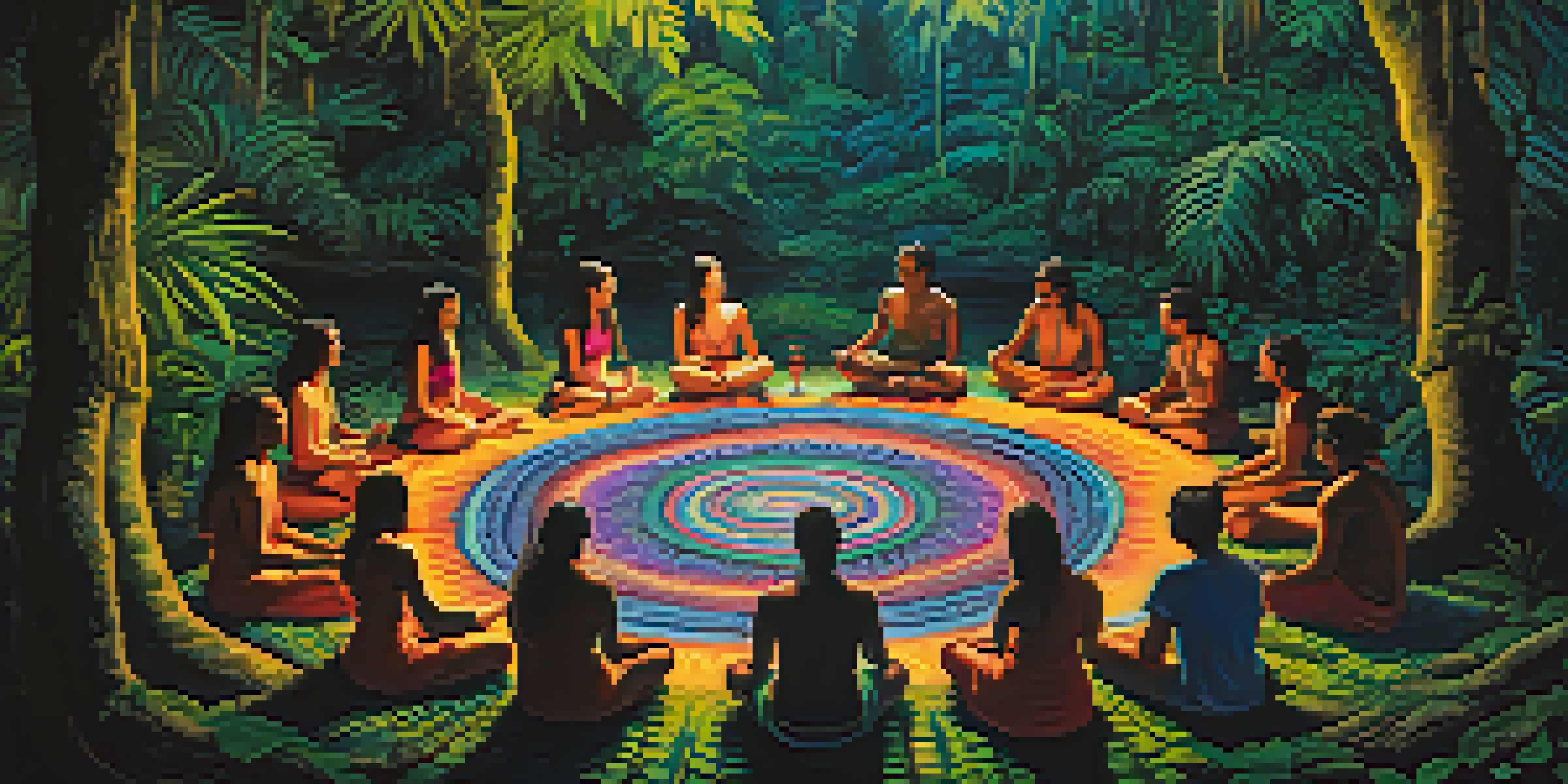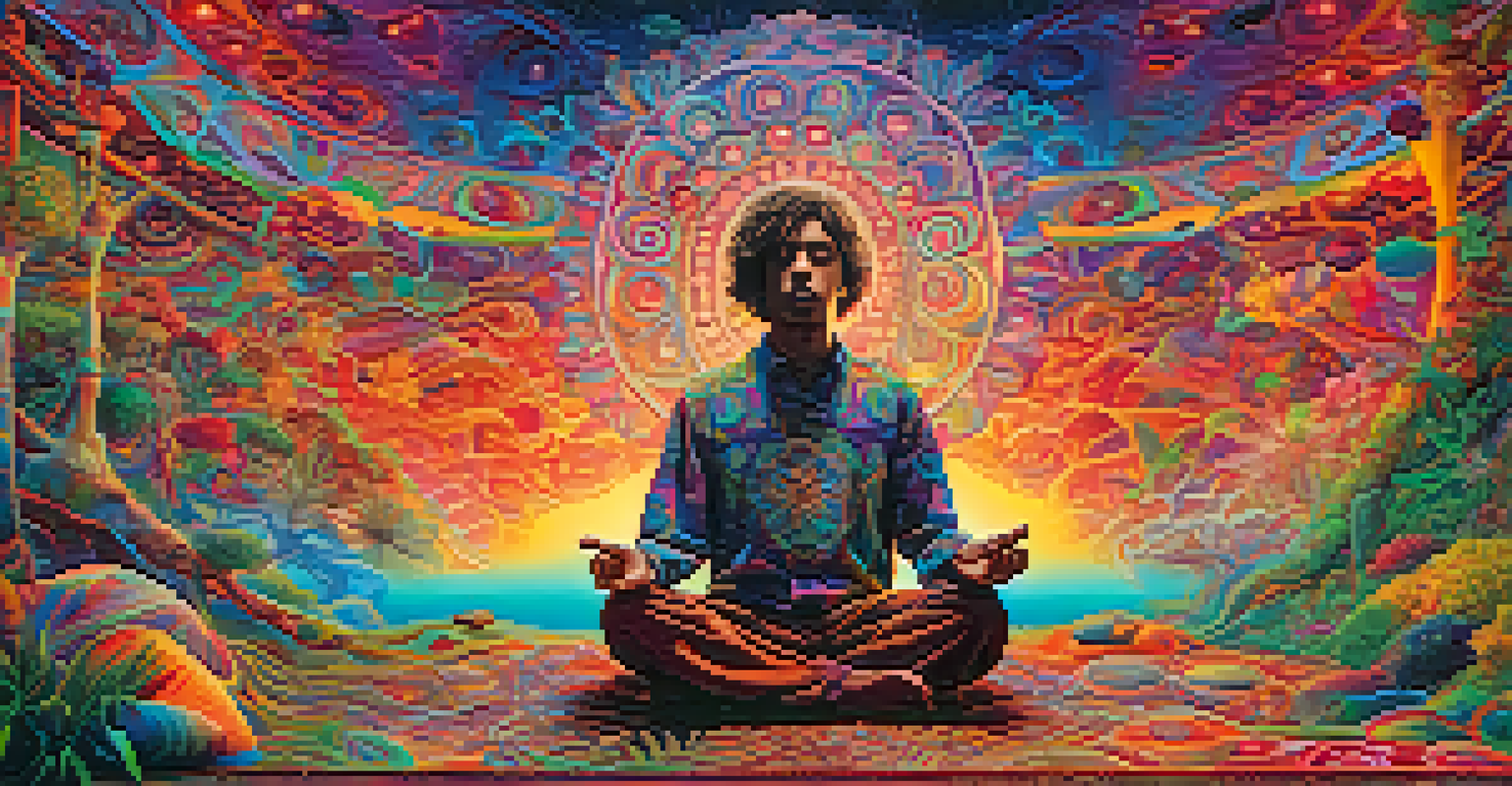Exploring Ayahuasca's Influence in Modern Film Narratives

Understanding Ayahuasca: A Cultural and Spiritual Journey
Ayahuasca is a powerful plant-based brew originating from the Amazon basin, traditionally used in spiritual ceremonies by indigenous communities. It combines two key ingredients, the Banisteriopsis caapi vine and the Psychotria viridis leaf, to create a hallucinogenic experience that many believe connects them to the spiritual realm. This unique brew has gained popularity in recent years, drawing attention not only for its psychoactive properties but also for its potential therapeutic benefits.
The experience of Ayahuasca is one of deep introspection and self-discovery, often leading individuals to confront their innermost fears and desires.
In the context of modern film, Ayahuasca represents more than just a hallucinogen; it embodies a journey of self-discovery and transformation. Many filmmakers are captivated by the rich cultural narratives surrounding Ayahuasca, using it as a tool to explore profound themes such as identity, healing, and the interconnectedness of life. This exploration has led to a resurgence of interest in stories that delve into the mystical experiences tied to this ancient ritual.
Moreover, Ayahuasca serves as a narrative device that challenges characters to confront their inner demons and ultimately evolve. Through vivid imagery and emotional storytelling, filmmakers can create an immersive experience that mirrors the intensity of an Ayahuasca journey. As audiences increasingly seek authentic and transformative experiences, the portrayal of Ayahuasca in film resonates deeply, inviting viewers to reflect on their own lives.
Ayahuasca in Film: A Catalyst for Personal Transformation
Many films featuring Ayahuasca focus on characters embarking on a quest for personal growth and healing. These narratives often depict protagonists grappling with trauma, loss, or existential crises, drawing parallels to the profound psychological insights often gained through Ayahuasca ceremonies. For example, in films like 'The Last Shaman,' the protagonist's journey into the Amazon serves as both a literal and metaphorical quest for redemption.

Through the lens of Ayahuasca, filmmakers can explore the complexities of human emotion and the struggle for self-acceptance. The hallucinogenic experience often acts as a catalyst that forces characters to confront their fears and ultimately leads to catharsis. This exploration of inner turmoil can resonate powerfully with audiences, making the character's journey feel relatable and authentic.
Ayahuasca's Cultural Significance
Ayahuasca is a traditional brew from the Amazon that plays a vital role in the spiritual practices of indigenous communities, serving as a bridge to the spiritual realm.
Additionally, these films often emphasize the importance of community and connection during the healing process. Ayahuasca ceremonies are typically communal experiences, highlighting the role of shared vulnerability in personal transformation. This collective experience is mirrored in film, showcasing how relationships can serve as a source of support and understanding during challenging times.
Cinematic Techniques: Visualizing the Ayahuasca Experience
One of the most striking aspects of films featuring Ayahuasca is the innovative use of visual techniques to depict the psychedelic experience. Directors often employ vibrant colors, surreal imagery, and dreamlike sequences to immerse viewers in the protagonist's altered state of consciousness. This creative approach not only brings the Ayahuasca experience to life but also elevates the emotional intensity of the narrative.
Films that portray Ayahuasca not only entertain but also invite viewers to reflect on their own journeys and the potential for transformation.
For instance, filmmakers may utilize slow-motion effects, kaleidoscopic visuals, or rapid cuts to convey the disorientation and beauty of a hallucinatory journey. This artistic representation helps audiences understand the complexity of emotions and insights that come during an Ayahuasca ceremony. By evoking a sense of wonder and introspection, these films can leave a lasting impression on viewers.
Moreover, sound design plays a crucial role in enhancing the immersive experience. The use of ambient music, nature sounds, and chanting can complement the visual elements, creating a holistic portrayal of the Ayahuasca journey. By engaging multiple senses, filmmakers can evoke a deeper emotional response, making the audience feel as though they are part of the experience.
Ethical Considerations: The Representation of Ayahuasca
As Ayahuasca gains popularity in mainstream media, ethical considerations about its representation in film come to the forefront. Filmmakers must navigate the fine line between cultural appreciation and appropriation, ensuring that they honor the traditions and practices of indigenous communities. This is especially important given that Ayahuasca is deeply rooted in the spiritual and cultural heritage of these populations.
Responsible storytelling requires filmmakers to engage with indigenous voices and perspectives, allowing for a more authentic representation of Ayahuasca's significance. By collaborating with those who have a genuine understanding of the ritual, filmmakers can create narratives that respect the cultural context while still resonating with broader audiences. This approach not only enriches the storytelling but also fosters greater awareness of the complexities surrounding Ayahuasca.
Transformational Themes in Film
Films featuring Ayahuasca often explore profound themes of personal growth and healing, reflecting the psychological insights gained through the ceremonial experience.
Furthermore, the commercialization of Ayahuasca in contemporary media raises questions about the potential risks of misrepresentation. Films that sensationalize or trivialize the experience can contribute to misunderstanding and exploitation of the practice. Therefore, it is vital for filmmakers to approach the topic with sensitivity and respect, ensuring that their narratives encourage informed conversations about the use of Ayahuasca.
Popular Films Featuring Ayahuasca: A Closer Look
Several films have prominently featured Ayahuasca, each offering a unique perspective on the experience and its implications. For instance, 'Embrace of the Serpent' explores the relationship between indigenous cultures and Western influences, highlighting the spiritual significance of Ayahuasca through stunning visuals and poignant storytelling. This film not only captivates audiences but also raises awareness about the importance of preserving indigenous wisdom.
Another notable example is 'The Medicine,' which follows a group of individuals as they partake in an Ayahuasca retreat. The film provides an intimate look into the personal journeys of each participant, showcasing the transformative power of the experience. By depicting the raw emotions and vulnerabilities of the characters, the film emphasizes the profound changes that can occur through Ayahuasca ceremonies.
Additionally, 'Icaros: A Vision' blends fiction and documentary elements to capture the essence of an Ayahuasca ceremony. This film immerses viewers in the rituals and traditions surrounding the experience while also telling a compelling story. By intertwining factual representation with narrative, it offers a holistic view of Ayahuasca's impact on individuals and communities.
The Future of Ayahuasca in Film: Trends and Predictions
As the conversation around mental health and alternative therapies continues to grow, the portrayal of Ayahuasca in film is likely to evolve. Filmmakers are increasingly interested in exploring the therapeutic potential of Ayahuasca, often incorporating themes of healing and self-discovery into their narratives. This shift reflects a broader societal interest in holistic approaches to well-being, paving the way for more nuanced representations.
Furthermore, the rise of streaming platforms has expanded opportunities for independent filmmakers to share stories centered on Ayahuasca. This democratization of content creation allows for diverse voices and perspectives to emerge, enriching the cinematic landscape. As audiences demand authentic storytelling, we can expect to see more films that delve into the complexities of the Ayahuasca experience.
Ethical Representation in Cinema
As Ayahuasca gains popularity, filmmakers must navigate the complexities of cultural appreciation versus appropriation to authentically represent its significance.
In the coming years, it will be essential for filmmakers to maintain ethical standards while exploring the cultural significance of Ayahuasca. By engaging with indigenous communities and emphasizing responsible storytelling, filmmakers can contribute to a more respectful portrayal of this ancient practice. As Ayahuasca continues to capture the imagination of audiences, its role in film narratives will likely remain a powerful and transformative force.
Conclusion: Ayahuasca's Lasting Impact on Cinema
Ayahuasca's influence in modern film narratives speaks to the universal quest for understanding and healing. By exploring the profound experiences tied to Ayahuasca, filmmakers can create stories that resonate deeply with audiences, inviting them to reflect on their own journeys. This connection to personal transformation and cultural significance enriches the cinematic experience, making it more than just entertainment.
Moreover, the ongoing exploration of Ayahuasca in film encourages conversations about mental health, spirituality, and the importance of cultural preservation. As viewers engage with these narratives, they are prompted to consider the complexities of human experience and the potential for healing through alternative practices. This dialogue can foster greater awareness and appreciation for indigenous cultures and their wisdom.

In summary, the portrayal of Ayahuasca in modern cinema not only captivates audiences but also serves as a catalyst for meaningful conversations. As filmmakers continue to navigate the delicate balance of representation and storytelling, the impact of Ayahuasca on film narratives will undoubtedly leave a lasting legacy, inspiring future generations to explore the depths of the human experience.